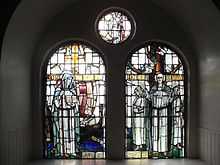Saint Moluag
| Saint Moluag | |
|---|---|
 | |
| Bishop of Lismore, Apostle of the Picts, Patron Saint of Argyll | |
| Born |
c. 500-530 northern Ireland |
| Died |
592 Rosemarkie |
| Venerated in | Roman Catholic Church, Anglican Church |
| Major shrine | Isle of Lismore |
| Feast | 25 June |
| Patronage | Argyll; on Lewis invoked against madness[1] |
Saint Moluag, (c.530 - 592),[1] (also known as Lua, Luan, Luanus, Lugaidh, Moloag, Molluog, Molua, Murlach),[2][3] was a Scottish missionary, and a contemporary of Saint Columba, who evangelized the Picts of Scotland in the sixth century.[4] Saint Moluag was the patron saint of Argyll as evidenced by a charter in 1544, from the Earl of Argyll, which states "in honour of God Omnipotent, the blessed Virgin, and Saint Moloc, our patron".[5]
Life
Moluag, born in Ireland,[1] was an Irish noble of the Dál nAraide[6] and was educated in Bangor, Ireland[1] under Saint Comgall.[3]
Tradition states that the rock on which Moluag stood, detached itself from the Irish coast and he drifted across to the island of Lismore, in Loch Linnhe.[7] According to the Irish Annals, in 562 Moluag beat Saint Columba in a race to the large island of the Lyn of Lorn in Argyll. Now called the Isle of Lismore, WS Skene claims it was the sacred island of the Western Picts and the burial place of their kings whose capital was at Beregonium, across the water at Benderloch.
Moluag was accompanied to Scotland by Comgall (like Moluag, an Irish Pict), who presented him to King Brude of the Northern Picts to obtain permission to carry on his mission of spreading Christianity. It is speculated that King Brude preferred Moluag to Columba because of Columba's close relation to the Gaelic leadership of Dál Riata, this could explain why Molaug evangelized largely Pictish areas and Columba stayed within the sphere of Dál Riata influence.
After founding an island monastery on the Isle of Lismore,[1] Moluag went on to found two other great centres in the land of the Picts at Rosemarkie and Mortlach. These were his three centres of teaching, and it is significant that all three were to become the seats of the Roman Catholic Sees of the Isles, Ross and Aberdeen. It is claimed in the biography of Saint Malachy that Moluag was the founder of 100 monasteries in Dark Ages Scotland.
Moluag died in Rosemarkie, Scotland on 25 June 592. The Annals of Ulster record the death of Lugaid of Les Mór in 592:[8] "Obitus Lugide Lis Moer."[9]
Moluag is said to have been buried at Rosemarkie on the Moray Firth, though his remains were later transported to Lismore, and honoured in the cathedral which bore his name.[7]
The Coarb, or successor, of Saint Moluag, is the Livingstone chief of the Clan MacLea. This Livingstone family of Lismore had long been the hereditary keepers of the crozier of the saint.[7] The bell of Saint Moluag was in existence until the sixteenth century when it disappeared during the Reformation.[7] An ancient bell found at Kilmichael Glassary, Argyll was thought to have been the lost bell.[7]
Veneration as a saint
"Saint" derives from the Latin word "Sanctus," meaning "holy," and is historically reserved in Christian tradition to those whose lives exhibited heroic virtue and sanctity, above and beyond what is ordinary. The feast day of Saint Moluag (25 June[1]) was restored in 1898 by Pope Leo XIII.[7]
He is one of the 48 Saints referred to in the Lorrha ("Stowe") Missal used by Churches of Ireland, Scotland, Britain, France, Germany, Switzerland, and northern Italy: "Saint Lua of Lismore, Pray for us".[10]
Legacy and dedications
Several churches were dedicated to Saint Moluag, including:
Other sites include churches at Clatt and Tarland, in Aberdeenshire; and also churches on Skye, Mull, Raasay, Tiree, and Pabay.[7] At Alyth in Perth and Kinross the ruins of a church, known today as "The Alyth Arches"[11] were built on the site of an older sixth-century church dedicated to the saint.[12]
At Mortlach in Banffshire, where some of his relics were preserved, an abbey was founded in 1010 by Máel Coluim II of Scotland, in thanks for a victory in which the Scots had invoked the aid of Saint Moluag.[7]
On Lewis Saint Moluag was invoked for cures from madness.[1]
At Clatt there was held annually "St. Mallock's Fair", which lasted eight days.[7] At Tarland there was a "Luoch Fair" which is thought to have been in honour of Saint Molaug,[7] and at Alyth "Simmalogue Fair" was celebrated.[12]
Trivia
In Scotland, the name Luke, is thought to be derived from Saint Moluag.[2]
Notes
- ↑ 1.0 1.1 1.2 1.3 1.4 1.5 1.6 The Oxford Dictionary of Saints, p.343
- ↑ 2.0 2.1 Saint of the Day, 25 June: Moloc of Mortlach SaintPatrickDC.org. Retrieved on 6 March 2012
- ↑ 3.0 3.1 Irish Saints in Great Britain, p.76-77
- ↑ http://www.catholic.org/saints/saint.php?saint_id=5153 Retrieved on 14 May 2007
- ↑ Clan Livingstone - Charter of 1544
- ↑ Lismore in Alba, p39ff
- ↑ 7.0 7.1 7.2 7.3 7.4 7.5 7.6 7.7 7.8 7.9 7.10 7.11 Barrett, M, A Calendar of Scottish Saints, p.97-99
- ↑ http://www.ucc.ie/celt/online/T100001A/ Retrieved on 19 May 2007
- ↑ http://www.ucc.ie/celt/published/G100001A/index.html Retrieved on 19 May 2007
- ↑ "Litany of the Saints" www.catholicforum.com
- ↑ http://www.scotland247.co.uk/alyth2.htm Retrieved on 12 June 2007
- ↑ 12.0 12.1 http://www.alythvoice.co.uk/07february.pdf Retrieved on 12 June 2007
References
- Barrett, Michael. A Calendar of Scottish Saints. Fort Augustus: The Abbey Press, 1919.
- Carmichael, Ian. Lismore in Alba.
- Farmer, David Hugh. The Oxford Dictionary of Saints. Oxford: Oxford University Press, 1992. ISBN 0-19-283069-4
- Moran, Rev. Patrick. Irish Saints in Great Britain. Dublin: M H Gill & Son, 1879.